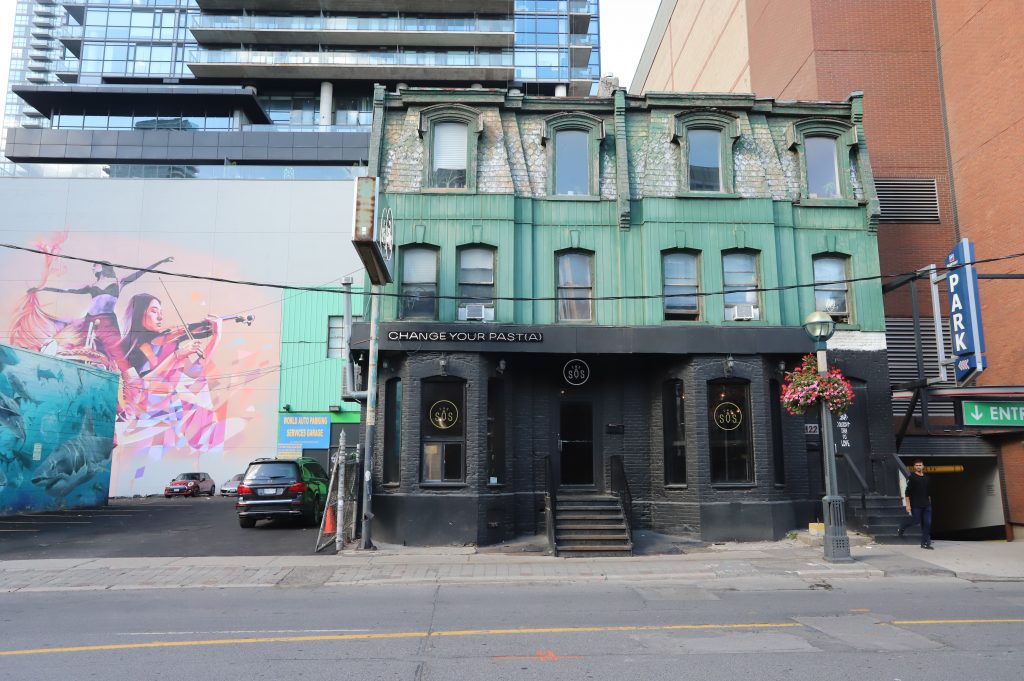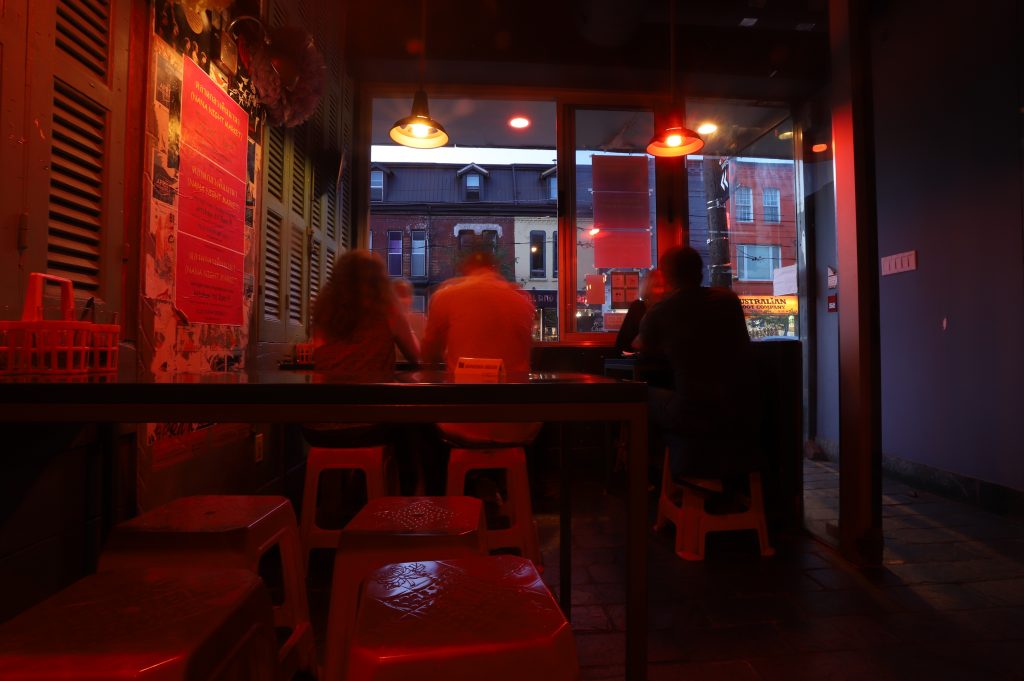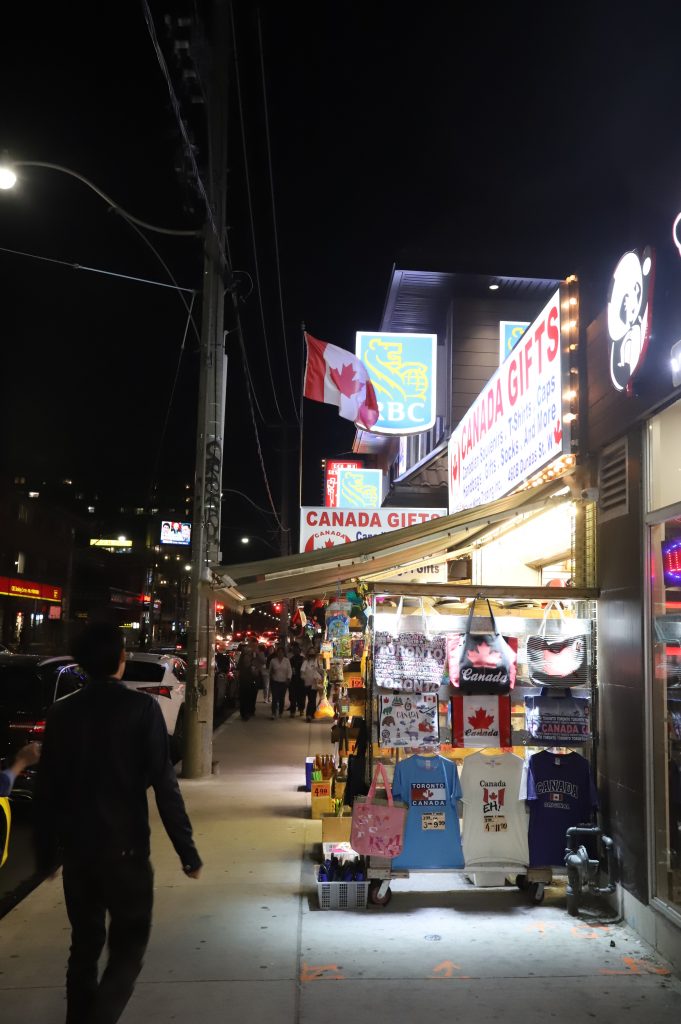Canada Trip V – Struggles of Canadian Ascendancy
It’s easy to go from the decaying infrastructure of a city like Detroit to a cleaner, more prosperous city like Toronto. One is astonished by the functionality of the city. Storefronts are occupied! Buildings are being built! There are streetcars that run with some frequency! Everyone is in love!
I first visited Toronto in January 2016 at what I’d term the beginning of my “Canada” phase. The Canadian dollar had just backed off a plunge to historic lows. It was a frigid Martin Luther King, Jr. weekend, and we had but youthful exuberance and ate our way through the city. I bought a stupid expensive coat that was handmade in Toronto out of worsted wool that has gotten me more mileage (kilometerage?) than most of my other purchases. Yea, tho they honor not the Doctor, the Canadians had a good little thing going in this city, we thought.
It’s a fun town. I was eager to come back for my study immersion program. We stayed off Yonge-Dundas Square, Toronto’s answer to a question about Times Square asked by nobody. The plaza is ringed by shopping centers and overpriced restaurants and permeated with jostling teenagers, Chinese tourists, panhandlers, and a motley array of buskers and artists. In my limited off-time, I visited old haunts and new destinations, riding buses and streetcars. Little Italy. Trinity-Bellwoods Park. The Islands.

Things are not by any means perfect. Transit connectivity is sometimes limited, though it still mostly possible to get anywhere within the core city in well under an hour. (In Detroit, trips within even the 7.2 can take over an hour on transit.) The transit system is not only inadequately connected, it’s also fairly illegible to someone unfamiliar with it. Signage is weak. Toronto has some of the ugliest corridor streetscapes of any city I’ve ever lived in (trailing slightly Hamtramck, Michigan). Automotive congestion chokes the city and gets worse each year, and it is unclear to me after having driven to Toronto twice and having taken the train in half a dozen times, why anyone would ever drive. A Canadian once told me that Toronto is great, but the problem is getting out of the city. Congestion pricing is something that has been vaguely mulled— but only vaguely.
Beyond congestion, affordability is, as everywhere these days, hard to find, with the average home price having crept up and up and up in recent years.
It’s not exactly a friendly city– in comparison to Detroit. Drivers are impatient and perhaps a bit less pedestrian-friendly than Montreal. But it’s certainly friendly in comparison to Chicago or New York. In alt-Chicago, servers will split checks without batting an eyelash, whereas in the Other Windy City, you typically get an exasperated sneer for asking for such an accommodation.
TORONTO, CANADA’S WELCOME MAT
The takeaway from the above critiques might be that Toronto is a big city like any other big city. But it’s notably pretty diverse. Some of our hosts in Toronto, which included Francotalianadian Lactalis-Parmalat, Accenture, and BDO (not to be confused with BMO), seemed to ascribe Toronto’s welcoming character to its cosmopolitanism and diversity.
They in turn linked that to Canada itself being a welcoming country. Justin Trudeau’s defense minister is a Sikh, as is the head of the New Democratic Party. If you listen to conservative critics, his brownface episode has undone any progress he’s made! But it’s notable that Trudeau’s racist costume charade preceded his decades-hence efforts to bring thousands of refugees into Canada. Is the government that diverse, though, overall? Let’s look at that a bit closer. Premiers and mayors across Canada are almost entirely white men— with some white women- with the notable exception of Naheed Nenshi in Calgary.
“It’s very different from the States,” one agency executive told us, practically bragging. “Rather than one party being pro-immigration and one other party being anti-immigration, all three of the major parties in Canada want immigration and recognize the need for immigration. They just can’t agree on whether they want to admit six hundred thousand immigrants per year or one hundred thousand.”
The description of a matter-of-fact, done deal was a bit odd to me. But I’ll return to that in a minute. It was during this trip that I considered the idea of what I’m calling “Canadian ascendancy.” I’m using this term to describe Canada taking a proactive leadership role in the global economy as the United States shrinks into the shadows and prioritizes opacity, corrupt deals conducted in obscurity, xenophobia, and a push to continue to transfer wealth upward.
Canada is by no means new to the global stage, as a founding member of NATO and the G7. But its role is increasingly important in light of conversations about climate change, the Arctic, and, significantly, in its leadership’s inclinations to challenge the United States as the Anglo-Western world’s spokesperson for pluralistic democracy.

LEGACIES OF COLONIALISM AND THE SOCIAL CONTRACT
I attribute some of Toronto’s sense of order to a particular Commonwealth sensibility. In contrast with the hyper-individualistic quest for elusive, meritocratic rewards that governs the free-for-all down in the United States, Canada respects that old school order imposed by that divinely appointed Monarch. I’m being a bit tongue-in-cheek here. I always used to joke to friends visiting Toronto that they should periodically drop in a “God save the Queen” for good measure, and they would look back at me, incredulous, before realizing I was joking. One of my Canadian friends tells me that Canada needed a monarch because Her Majesty provided necessary continuity in the discourse that was not afforded by an ever-changing prime minister.
The strange colonial ties between Anglo traditions of sociopolitical order, colonialism, and the Canadian State are hard to understand as an American. I once heard a rare speech by the Governor General, the Queen’s mostly ceremonial liaison, where he made a reference to the things that separate us from the “savage.” In the era of brutal callout culture in the United States amid a deteriorating discourse brought on by a Commander in Chief who values belittling and denigration above, well, governing, this would not have stood. I remember thinking it was instructive, even if he didn’t mean to use that specific word.
On a warm evening, I dined with a friend on the patio of the Queen Mother Café downtown, an old school pub that serves up some of the best southeast Asian curry in the city. Her people are from Pakistan. I asked her if she liked the spot so much because it is this ultimate embodiment of this paradox of colonialism, this casual love of faraway food couched in a quotidian, consumer homage to mother Britain. A sort of, “Hey, you might have conquered our people, but our food is always gonna be better.”
We don’t exactly have this same juxtaposition in the US because, even if our tradition is more starkly rooted in violence (N.B.: Genocide of the Native Americans, slavery), the US’s strength has, until fairly recently, at least done a good job of marketing itself as being welcoming to newcomers. The Statue of Liberty was an icon that welcomed European immigrants as one of the boldest icons of democracy.
Every time I visit a new place, I think a lot about the social contract and how it’s different from the US. In Germany, for example, one simply does not jaywalk. Crossing against a red ampelmann can induce a kindly grandmother to cuss you out.
In Canada, in comparison to the States, especially, people can seem excessively polite and deferential. The idea of a political scandal is comparatively benign. Canadians are, by and large, less fiery and less angry. I attribute a lot of this to the Canadian State’s being a bit more benevolent than that of the US. Socialized medicine, for example, eliminates a major fiscal stressor from the household budget (imperfect though it is). Canada has always played second fiddle to its bully of a big brother down south, being historically somewhat less successful, somewhat less wealthy, perhaps somewhat less genocidal. (One comedian on CBC once made a pretty brutal comparison between Canada’s benign birth from Mother Britain versus the crack baby that was the United States.)

PLURALISM, BUT LIMITED?
But cuddly pluralism has its limits, as well as monsters lurking behind a façade. One need not even think of Justin Trudeau’s brownface scandal, but might think back to Canada’s far more troubled history of residential schools. I hadn’t entirely realized until recently that these were operated well into the latter half of the 20th century. The State essentially kidnapped native children and attempted to erase their native identity in the name of Anglo-Canadian assimilation. Canada has, however, energetically pushed the truth and reconciliation issue, and I am hopeful that it is possible to move beyond mere consultation toward substantive inclusivity and investment in native communities.
One of our speakers held, we thought, a broadly pluralistic view until he tangentially lashed out at Afro-Caribbean populations. He said that if they wanted a seat at the table, they had to demand it and, basically, step up. This pissed off members of our group, who pointed out that a guy giving a talk to a group that was half or more composed of “visible minorities” about multiculturalism should probably come up with something better to say. It was not only tone-deaf for the audience but it betrayed a pretty shitty understanding of power dynamics in a society historically governed by a white power elite. (Toronto Mayor John Tory is white. Vancouver Mayor Kennedy Stewart is white. The Mayors of Brampton and Mississauga are white. All of these cities have a majority nonwhite population.)
Ironically, this guy also came at me for asking about threats to the tenuous stability of pluralism from the Canadian political climate. I used Jason Kenney and Doug Ford as examples of the rise of far-right populism.
“You picked on the wrong guy!” he moaned, arguing that Jason Kenney speaks a few languages and served as Steven Harper’s immigration minister, so he can’t possibly be racist. This was reminiscent of the “Some of my best friends are blacks!” defense. (I’ve written about Kenney’s affinity for union-busting, gay-hating, and drill-baby-drill-ing).
The exchange was, however, instructive.
We jest oft about Canadians being too apologetic, as immortalized in the joke rap song, Out For A Rip, in which the protagonist, F*ckin’ Buddy, observes, “when I’m down in the states, they’re like, ‘you’re too f*ckin’ nice!” But many Canadians harbor a singular sort of apologism toward their society that I also trace to some sort of Anglo-colonial affinity for the State. Americans have this, too, but we also have a fiery streak– tempered with the blood of the workers slaughtered in the labor movement, perhaps, or that of those killed at Gettysburg or Antietam. The legacy of slavery, plus the extraordinary contributions of black Americans that formulate the very cultural, political, and social underpinnings of a society that in no small part sought to erase them, has always provided for a vibrant culture of critique of the State, even if it hasn’t solved every problem, or even if it has suffered violent backlash from the State.
This is not to say that Canada is, as a country, wrong. Many of the points raised by our hosts included the important fact that there isn’t really any universal right or wrong with regard to cultural viewpoints– there is just inclusivity versus intolerance. We have limits. No one wants a Wahhabist government in the United States or Canada or Mexico.
LOOKING FORWARD
The future of the world hangs in the balance as the major powers are in some unique, unprecedented shitshow of cultural struggle. France’s Macron has been a letdown. It is unclear what is going to happen at the end of Angela Merkel’s reign in Germany, where the far-right AfD party has been gaining traction in that country’s equivalent of the postindustrial Midwest. Outside the G7, Putin doesn’t believe in democracy anyway, the Saudis are chopping up journalists, Erdogan is murdering Kurds, and the Chinese are putting Muslims in concentration camps.
In light of Trudeau’s reëlection, it’s now a question of whether Trump will retain his own office. If that happens, it will starkly illustrate this question of Canadian ascendancy– contrasted with the United States’ willingness to decimate decades of progress toward multilateralism in favor of nativism, racism, xenophobia, and the disintegration of civility, discourse, infrastructure, and more and more. I’m hoping my own home and native land can figure out its own problems. I’m also hoping that we can ensure that 2020 instead sees the election of a leader who can collaboratively work with a Canadian peer to formulate pluralistic, forward-thinking policy.
This article is the final in a series of five on Canadian culture and economy surrounding my study trip to Québec and Toronto in September 2019. The preceding articles are listed below.


